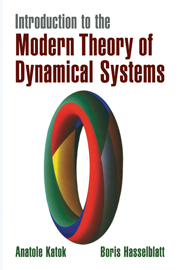Book contents
- Frontmatter
- Contents
- PREFACE
- 0 INTRODUCTION
- Part 1 Examples and fundamental concepts
- Part 2 Local analysis and orbit growth
- 6 LOCAL HYPERBOLIC THEORY AND ITS APPLICATIONS
- 7 TRANSVERSALITY AND GENERICITY
- 8 ORBIT GROWTH ARISING FROM TOPOLOGY
- 9 VARIATIONAL ASPECTS OF DYNAMICS
- Part 3 Low-dimensional phenomena
- Part 4 Hyperbolic dynamical systems
- Appendix: BACKGROUND MATERIAL
- NOTES
- HINTS AND ANSWERS TO THE EXERCISES
- REFERENCES
- INDEX
9 - VARIATIONAL ASPECTS OF DYNAMICS
Published online by Cambridge University Press: 05 June 2012
- Frontmatter
- Contents
- PREFACE
- 0 INTRODUCTION
- Part 1 Examples and fundamental concepts
- Part 2 Local analysis and orbit growth
- 6 LOCAL HYPERBOLIC THEORY AND ITS APPLICATIONS
- 7 TRANSVERSALITY AND GENERICITY
- 8 ORBIT GROWTH ARISING FROM TOPOLOGY
- 9 VARIATIONAL ASPECTS OF DYNAMICS
- Part 3 Low-dimensional phenomena
- Part 4 Hyperbolic dynamical systems
- Appendix: BACKGROUND MATERIAL
- NOTES
- HINTS AND ANSWERS TO THE EXERCISES
- REFERENCES
- INDEX
Summary
The purpose of this chapter is to introduce the variational approach to dynamics, that is, to show how interesting orbits in some dynamical systems can be found as special critical points of functionals defined on appropriate auxiliary spaces of potential orbits. This idea goes back to the variational principles in classical mechanics (Maupertuis, d'Alembert, Lagrange, etc.). The classical continuous-time case presents certain difficulties related to infinite-dimensionality of the spaces of potential orbits. In order to demonstrate the essential features of this approach and to avoid those difficulties we start in Section 2 with a model geometric problem describing the motion of a point mass inside a convex domain. Then we consider in Section 3 a more general class of area-preserving two-dimensional dynamical systems, twist maps, which possesses the essential features of that example, but covers many other interesting situations. The main result there is Theorem 9.3.7, which guarantees existence of infinitely many periodic orbits with a special behavior for any twist map. At least as important as that result itself is the machinery involving the action functional (9.3.7) for the periodic problem, which will be extended in Chapter 13 to give results about nonperiodic orbits. Furthermore, after developing the necessary local theory, the approach can then be refined to study continuous-time systems as well, although we only carry out the program for geodesic flows, where the action functional has a particularly clear geometric interpretation.
- Type
- Chapter
- Information
- Introduction to the Modern Theory of Dynamical Systems , pp. 335 - 378Publisher: Cambridge University PressPrint publication year: 1995



